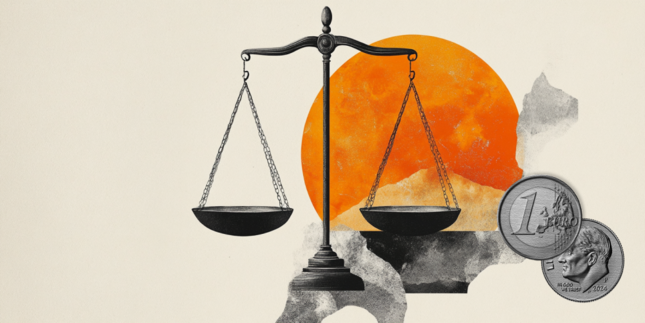Three macro considerations are shaping the investment climate: the evolution of the virus and the response, the timeframe of the Fed's tapering, and China's broad regulatory crackdown.
Beijing's new policy initiatives are broader and quicker than generally anticipated. Officials seem to be opening up several different fronts, including anti-trust, data protection, discouraging foreign capital raising, and private education reform. The common element is reining in what officials may see as excesses. It dovetails with other efforts seeking to strengthen the Communist Party's command and control functions.
Beijing seemed unaware or uninterested in the broader implications. The inclusion of the yuan into the IMF's Special Drawing Rights (SDR) and Chinese stocks and bonds into global benchmarks represents a new integration phase. Recent estimates suggest foreign investors have doubled since 2015 to around $550 bln and around the same amount of Chinese bonds. However, foreign investors have been adversely impacted by the sharp drop in Chinese and Hong Kong equities, and, given the driver, may have a cooling effect on future allocations. It wasn't until the sell-off in Chinese stocks accelerated to new lows for the year, interest rates jumped, and the yuan sold to new three-month lows that Beijing moved to stabilize the markets.
China is doing what some of its critics were struggling to accomplish, namely, discourage further integration of China into the global capital markets. A year ago, the Trump administration prohibited federal pension fund investment in China. Ahead of the weekend, the SEC announced it would freeze the application process for Chinese IPOs and the sale of other securities on concerns about the risk disclosure. In addition, Chinese companies face being delisted from US exchanges if they continue to refuse to share audits with regulators.
There has been a pushback against claims of decoupling by focusing on the trade of goods and services. But trade is a small part of the integration and is stickier than capital flows. Moreover, trade can be a shallow kind of integration. Direct investment, listing on exchanges, patent registrations, incorporation of industry standards seem to be a deeper commitment.
If there are more sustained outflows from China, the natural question is where they may go. However, in the first instance, it seemed to weigh on global equities. Interest rates fell, and curves tended to flatten, which is also consistent with delayed or weaker recoveries, making price pressures less likely to be sustained.
In the foreign exchange market, the spread of the Delta variant and Chinese developments weighed on those currencies that are perceived to be levered to world growth, with relatively high volatility, and frequently seen as an expression of risk appetites: the dollar-bloc and Scandis, and all but Sweden were seen to be ahead of the Federal Reserve in adjusting monetary policy. As a result, they have underperformed over the past few weeks. At the same time, the strongest two currencies, the yen and Swiss franc tend to be used as funding currencies to purchase higher returning or more volatile assets. As the risk assets are liquidated, the funding currency is typically bought back. However, as July drew to a close, the funding currencies are lagging behind the dollar bloc and Scandis.
The high-frequency data highlight of the week ahead is the US employment report. Once again, some economists are forecasting an increase of more than a million jobs in July. After the nearly 20.7 mln loss of employment in April 2020, the US did add more than a million jobs in May-August last year. June's 850k estimate is the largest so far this year. The median forecast in Bloomberg's survey anticipates July's nonfarm payrolls rising by about 900k, which has drifted a little lower in recent data. Job growth, largely people returning to their jobs, averaged 567k in Q2 after 518k in Q1.
The unemployment rate is projected to fall to 5.7% from 5.9%. At the end of 2019, the average unemployment rate for the past decade (120 months) was 6.2% and 5.9% for 20-years (240 months). The underemployment rate (U-6) has fallen from nearly 23% in April 2020 to 9.8% in June. Not to include the impact of the pandemic and recovery, we looked at the same long-term averages as of the end of 2019, and they stood at 11.7% and 10.7%, respectively.
A robust employment report would mean the earliest window for the Fed to signal its intention on the pace and composition of its bond-buying would be the Jackson Hole conference at the end of August. By the time the Fed meets in September, there will be another employment report, and there may be more clarity about the impact of the growing virus. Fed Chair Powell has pledged an advanced warning to the market about its decision about tapering.
The hawk camp wants to taper, and some want to focus on the MBS purchases, and the sooner, the better. The dove camp is in no hurry and seems somewhat less convinced that those purchases drive up house prices, which have continued to soar at a record pace according to the S&P CoreLogic Case-Shiller 20-city 17% year-over-year in May. The FHFA house price index has risen by more than 1% a month since June 2020. It is more than twice the pace that it had averaged in 2016-2019.
In practical terms, the hawks seem to prefer tapering later this year, which if this window is going to remain open, some clearer guidance needs to be provided soon (September). The doves may be more inclined to start the actual tapering next year, clear of the debt ceiling issue, and have a better understanding of the sustainability of price pressures and after income support programs expire. Tactically, with note and bond yields at several month lows, and record-low real rates, some officials see these conditions as ideal to announce its intention to taper in the coming months. The market has provided a cushion for an exaggerated reaction that cannot be ruled out.
For long-term investors and corporate Treasurers, it might not be a big difference between tapering late 2021 or early 2022. However, many will extrapolate from slowly taking a foot off the accelerator to tapping on the brake. The December 2022 Eurodollar futures contract implies a three-month yield in 16 months of about 40 bp. The current three-month rate is about 13 bp. That implies a 25 bp hike is anticipated. Recall that a significant minority of Fed officials (7/18) anticipated in June that a hike by the end of next year would be appropriate.
Other central banks meet next week. The Reserve Bank of Australia (August 3) meets with rising cases in Sydney, despite the lockdown and the economic fallout being picked up in some recent data, including June's preliminary retail sales (-1.8% month-over-month, more than twice the decline expected) and a flash composite PMI crashed to 45.2 from 56.7. It looks likely to provide more support through stepped-up bond buying. The RBA is currently buying A$5 bln a week and may increase by A$1-2 bln.
The Bank of England also meets (August 5). Rising inflation and an economy clearly on the mend have seen a few MPC officials turn more hawkish. The risk of a dissent in favor of a reduction in bond purchases may have increased, but until the furlough program concludes at the end of September, the health of the labor market is not clear. Nevertheless, the market appears to be pricing in a hike in the second half of next year. Early signs that the wave of infections may be slowing may have lent support to sterling. Meanwhile, the 10-year Gilt yield hovers around the 200-day moving average (0.55%) after peaking slightly above 0.92% in mid-May.
Four central banks from emerging markets meet next week. Thailand is the least likely to alter policy. India is unlikely to change rates but will announce its August bond purchases. The RBI may have to recognize and tolerate slightly higher inflation. The Czech central bank began a tightening cycle in June and most likely follow-up with another 25 bp rate at the August 5 meeting. Another 50 bp of increases appears to be discounted before the end of the year. Brazil's central bank has hiked the Selic rate by 225 bp this year (to 4.25%) with three 75 bp rate hikes. Inflation is still accelerating (the IPCA measure stood at 8.35% year-over-year, a five-year high. With the economy seemingly on the course for a strong recovery and the currency off around 2.4% in July, the central bank may be emboldened to deliver a 100 bp hike.
Opinions expressed are solely of the author’s, based on current market conditions, and are subject to change without notice. These opinions are not intended to predict or guarantee the future performance of any currencies or markets. This material is for informational purposes only and should not be construed as research or as investment, legal or tax advice, nor should it be considered information sufficient upon which to base an investment decision. Further, this communication should not be deemed as a recommendation to invest or not to invest in any country or to undertake any specific position or transaction in any currency. There are risks associated with foreign currency investing, including but not limited to the use of leverage, which may accelerate the velocity of potential losses. Foreign currencies are subject to rapid price fluctuations due to adverse political, social and economic developments. These risks are greater for currencies in emerging markets than for those in more developed countries. Foreign currency transactions may not be suitable for all investors, depending on their financial sophistication and investment objectives. You should seek the services of an appropriate professional in connection with such matters. The information contained herein has been obtained from sources believed to be reliable, but is not necessarily complete in its accuracy and cannot be guaranteed.
Recommended Content
Editors’ Picks

EUR/USD trims losses and approaches 1.0800 after US data
The US Dollar renewed its bullish momentum on Tuesday, pressuring EUR/USD and keeping the pair under the critical 1.0800 threshold following the release of US ISM Manufacturing PMI and JOLTS readings.

GBP/USD meets support around 1.2880, USD remains strong
After bottoming out around the 1.2880 region, GBP/USD now manages to attempt a bounce and flirt with the 1.2900 zone in the wake of weaker-than-expected US data releases.

Gold looks range bound above $3,100
Gold is easing from its fresh record high near $3,150 but remains well supported above the $3,100 mark. A generalised pullback in US yields is underpinning the yellow metal, as traders stay on the sidelines awaiting clarity on upcoming US tariff announcements.

Dogecoin bulls defend lifeline support as risk-off sentiment continues
Dogecoin trades at $0.1731 during early American hours on Tuesday after recovering from Monday’s support at $0.16. The leading meme coin faced negative headwinds early in the week as investors reacted to comments by Tesla CEO Elon Musk, who heads the special Department of Government Efficiency (D.O.G.E.) in the US.

Is the US economy headed for a recession?
Leading economists say a recession is more likely than originally expected. With new tariffs set to be launched on April 2, investors and economists are growing more concerned about an economic slowdown or recession.

The Best brokers to trade EUR/USD
SPONSORED Discover the top brokers for trading EUR/USD in 2025. Our list features brokers with competitive spreads, fast execution, and powerful platforms. Whether you're a beginner or an expert, find the right partner to navigate the dynamic Forex market.